- NLI Research Institute >
- Revised Economic Forecast for FY 1997-Economy Averts Slump in Second Half With 1.1% Growth-
Revised Economic Forecast for FY 1997-Economy Averts Slump in Second Half With 1.1% Growth-
the Economic Research Dept.
Font size
- S
- M
- L
1. The Domestic Economy − Meager Improvement in the Second Half
(1) Present Status
The economy's stagnation is clear from the deterioration in economic indicators since April. The reactive decline in consumption following the consumption tax hike, as well as the effect of the consumption tax hike and end of special income tax cuts, have been major reasons for continued monthly year-on-year declines in automobile and large retail store sales, while housing starts have undercut year-ago levels for eight straight months. Industrial production has been mostly level, edging down -0.4 percent in the July-September quarter due to the slump in final domestic demand and inventory adjustments in automobiles and electrical equipment.
Meanwhile, the economy is being sustained by external demand, as the strong European and U.S. economies and weak yen continue to boost exports, alleviating the slump in private sector demand. The current surplus expanded to 13.1 trillion yen (2.6 percent of nominal GDP) in the April-June quarter, a caution zone for trade friction.
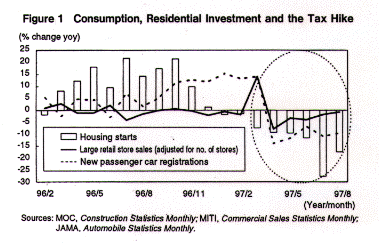
(2) The Economy in Fiscal 1997
The economy's medium term prospects also remain lackluster amid the nonperforming loan problem, poor corporate balance sheets, foreign competition, and a pessimistic business sentiment.
While the economy will remain weak in the near future, it will manage to improve in the second half of fiscal 1997, as: (1) capital investment and external demand continue growing, (2) consumer spending is boosted by rising employment and other gradual improvements in the income environment, and (3) inventory adjustment is mild and short in duration.
Real GDP growth for fiscal 1997 will be 1.1 percent, a decline from the 2.9 percent growth in fiscal 1996.
1. Forecast Assumptions
- Public expenditures: No additional fiscal spending packages
- Exchange rate (annual average): ¥115 / $1
- Official discount rate: Unchanged from the present 0.5 percent
Our forecast revision takes into consideration the following factors: (1) the consumption rush prior to the tax hike and decline afterward have both been more pronounced than we had predicted, (2) capital investment is losing vigor, and (3) the growth in external demand has exceeded our prediction. However, we stand behind our basic outlook that the economy will pick up later in the year.
Since the downward revisions in consumption and residential investment outweigh the improvement in external demand, we have revised our forecast for real GDP growth in fiscal 1997 to 1.1 percent (from 1.6 percent in our previous forecast).
Impact of Tax Increases on Households
Private consumption in the April-June quarter fell 5.7 percent from the previous quarter, posting the largest decline since the first oil shock. Since this decline exceeds the 4.4 percent gain in the January-March quarter, some observers believe that consumption is on a downtrend. However, we disagree with this view based on a closer look at consumption indicators.
The consumption indicators show signs of recovery in product categories excluding automobiles and some electrical products such as airconditioners. Women's apparel was positive in July and August, and total home electrical appliances turned positive in August.
Real GDP growth in the April-June quarter fell to -2.9 percent (qoq) as the brunt of the post-tax-hike consumption decline and other effects of the tax hikes were played out. We should see significant growth in the July-September quarter as these effects fade out.
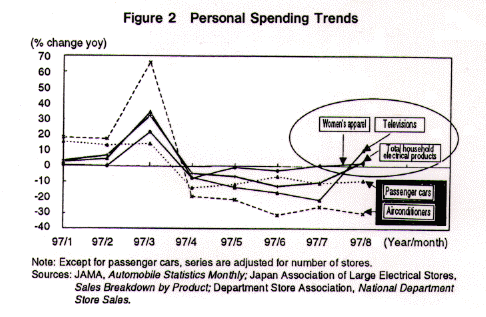
Capital Investment
Capital investment in the April-June quarter dropped 1.5 percent from the previous quarter, the first decline in ten quarters. This decline can largely be attributed to growing caution toward investment as consumption slumps.
However, while profit growth has declined, profits are increasing in undertone, In addition, planned investment is up from the previous fiscal year, and machinery orders, a leading indicator for investment, remains on an uptrend. Based on these observations, we predict that capital investment will continue its growth undertone.
Moreover, as various surveys on capital investment plans indicate, the delayed recovery in investment among small and mid-sized companies and non-manufacturing industries means that there are no leading sectors to spur investment. Thus the growth pace of investment will decline from 6.4 percent in fiscal 1996 to 2.9 percent in fiscal 1997.
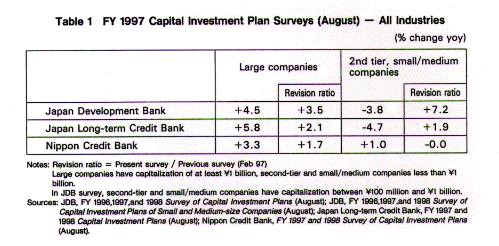
Inventory Adjustment
The producer inventory index rose to 111.4 in late April 1997, the highest level since early 1993. However, while small inventory increases are visible in steel and other material industries, most of the recent inventory increase is limited to large increases in the electrical machinery and automobile industries.
Inventory adjustment will have only a limited impact on production growth, which we predict will be negative in the July-September quarter and unchanged in the October-December quarter.
External Balance
Since bottoming out in the April-June 1996 quarter, the current account surplus has shown a clear expansive trend. This can be attributed to a recovery in exports due to (1) the sustained weakness of the yen, exceeding the breakeven exchange rate of exporters, and (2) strength of U.S. and other overseas economies. The current surplus grew at a 13.1-trillion yen annual rate in the April-June 1997 quarter as the slump in domestic demand decreased imports while companies shifted their emphasis to exports.
While the current surplus may edge down in the July-September quarter, if the exchange rate meets our forecast assumption and remains above the breakeven exchange rate of exporters, the current surplus will grow from7.2 trillion yen in fiscal 1996 to 12 trillion yen in fiscal 1997 (2.3 percent of nominal GDP).
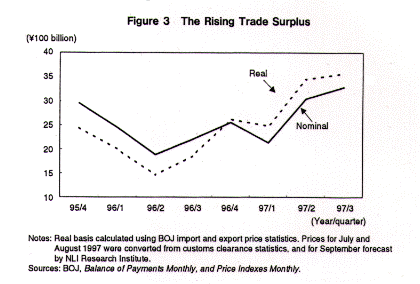
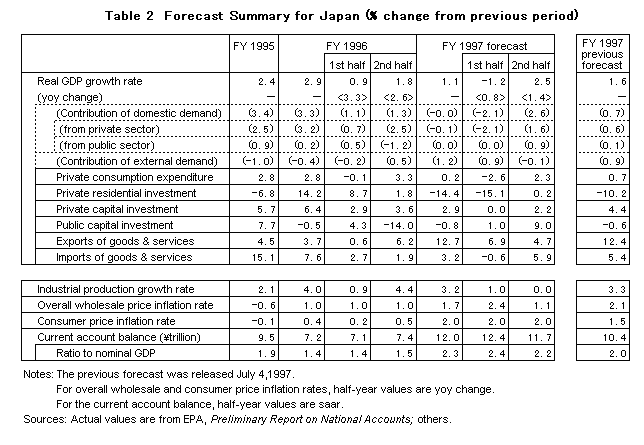
2. Monetary Policy and Interest Rates − No Policy Changes During Fiscal 1997
(1) Present Status
Over two years have elapsed since September 1995, when the discount rate was lowered and unsecured call rates were induced downward to their present levels.
Long-term interest rates declined during this period. In April 1997, government bonds with the longest maturity dipped to a record low. Despite a temporary resurgence, they resumed their decline in late May amid the recovery's stagnation and decline in business sentiment. The June 25 BOJ Tankan survey, which revealed the delayed recovery in non-manufacturing and small and mid-sized company sectors, and the Quarterly Economic Outlook released on July 24 prompted the BOJ to adopt a grimmer stance on the economy, leading to a further decline in interest rates. After both the EPA and BOJ acknowledged the economy's weakness in August, interest rates fell to new lows in late August and continued falling; indicator issues are hovering around 1.9 percent.
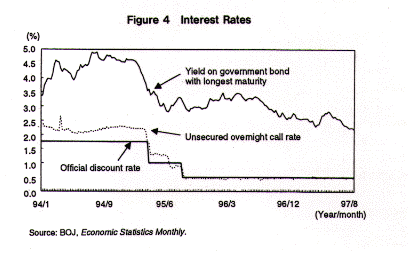
Stock prices began dropping in mid August amid strong pessimism, financial scandals, successive failures of construction companies, and the peaking out of the U.S. stock market. Unable to shrug off its pessimistic economic outlook, Japan's stock market still remains soft.
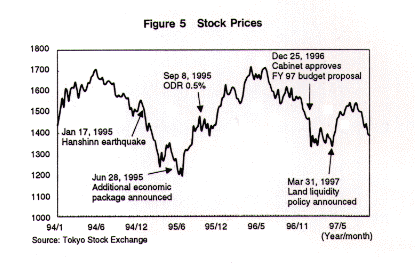
(2) Policy Rates to Stay Unchanged While Long-term Rates Edge Up
Considering the economy's weakness, fiscal tightening, and lingering problems with bad loans and corporate balance sheets, we predict that the low interest rate policy will basically remain unchanged. With the economy barely managing to turn around in the second half of fiscal 1997, monetary policy will remain unchanged during fiscal 1997.
The NLI Research Institute's interest rate leading indexes are subdued, and have not yet signaled any likelihood of a series of interest rate hikes (Index I must be at least 80 percent for three consecutive months).
We predict that long-term rates will stay level for the time being as financial markets remain deeply concerned over the economy's stagnation, but edge up toward the end of fiscal 1997 as the economy recovers.
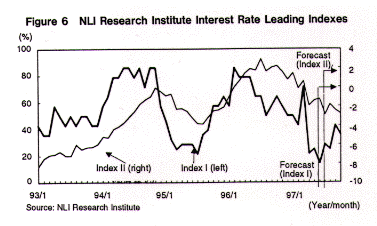
3. Exchange Rates
(1) Present Status − Strong Downward Pressure on the Yen
The yen/dollar exchange rate rose from mid December 1996 to the mid 120 yen range amid strong pessimism over Japan's economy. However, it returned to the 110 yen range in early May 1997 due to encouragement from monetary authorities, the declining disparity in economic conditions between Japan and the U.S., and concerns expressed by U.S. monetary authorities over the widening current surplus. Presently, although the yen again faces strong downward pressure as Japan's economic prospects worsen and interest rates plunge, the strong declaration of the G7 meeting in Hong Kong (September 20) and watchfulness of monetary authorities suggest that downward pressure on the yen will be limited.
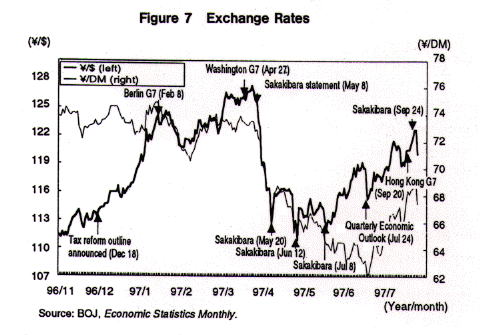
(2) Yen to Appreciate Moderately
The medium-term phase of the weak yen against the dollar lasting from April 1995 has ended. In the second half of fiscal 1997, the yen will appreciate to approximately 110 yen as Japan's external surplus grows, the economy recovers, and monetary authorities shift to a stronger target exchange rate range. We predict an average exchange rate for fiscal 1997 of 115 yen, based on the following factors.
- Japan's large current surplus − Since 1971, the yen has surged in four phases against the backdrop of an expanding current surplus. The yen will appreciate again, although moderately, because the surplus is not expected to grow as much as in the past.
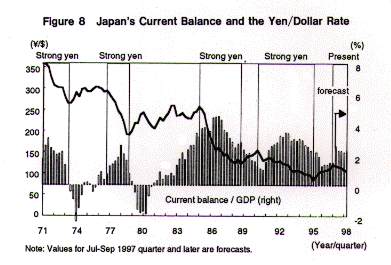
- Business climates and interest spread in the U.S. and Japan − The interest rate spread between the U.S. and Japan is expanding due to the recent plunge in long-term rates in Japan. However, from late fiscal 1997, we expect the spread to decrease moderately as interest rates in Japan tend to rise.
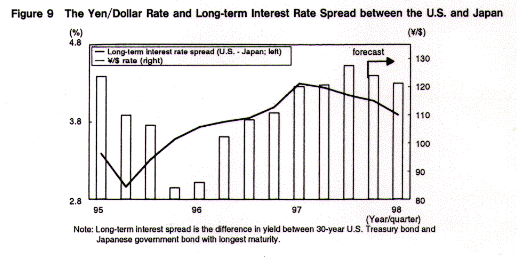
- Stance of monetary authorities − Due to Japan's large external surplus and slowdown in the U.S. economy, both U.S. and Japanese monetary authorities will shift their exchange rate target range toward a stronger yen in late fiscal 1997 while monitoring the condition of Japan's economy.
4. Overseas
(1) North America
While the U.S. economy will slow down slightly during in second half of 1997, North America will maintain an expansionary undertone due to Canada's sustained high growth.
In the first half of 1997, the U.S. economy grew a robust 4.4 percent over the previous half. However, growth will decline to 2.6 percent in the second half due to adjustment of excess inventories from the first half, and sluggishness in net exports, which had improved substantially in the second quarter. These negative factors will be partly offset in the third quarter by strong consumer spending growth of approximately 4 percent (quarterly change, annualized), putting the economy at mid 2 percent growth. But as consumer spending abates in the fourth quarter, the economy will slip under 2 percent growth.
We predict real GDP growth of 3.6 percent for 1997. In 1998, growth will continue at a slower pace due partly to weakness in consumer spending.
Inflation remains stable despite the economic growth in excess of the approximately 2 percent potential growth rate. In addition to a large drop in energy prices, goods prices have maintained a stable undertone overall. However, the labor market remains tight, and hourly wages have risen 3.5 percent from year-ago levels. Moreover, the labor participation rate remains unable to exceed 67 percent, indicating that the labor supply cannot expand much further. Due to such lingering inflationary concerns, the FRB will raise interest rates slightly by the end of the year.
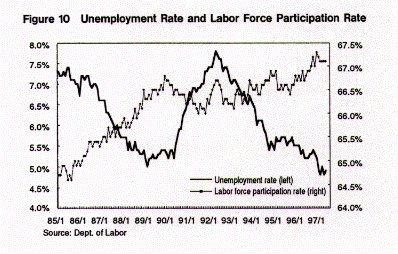
Canada is maintaining its expansionary undertone begun in the second half of last year. In the second quarter of 1997, real GDP growth rose to 4.9 percent (quarterly change, annualized). The economy is being led by automobile and home sales. With strong corporate earnings also supporting steady capital investment, we predict that domestic demand will continue to power the economic recovery as the economy grows 3.6 percent in 1997. However, since the savings rate is already low and can decline no further, the pattern of recovery in 1998 will shift away from the present reliance on domestic demand. Inflation will be stable due to little upward wage pressure and strong labor productivity growth.
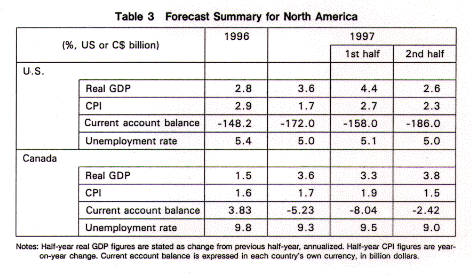
(2) Europe − The Shrinking Gap Between the U.K. and Germany
The growth rate of the U.K. economy will rise from 2.3 percent in 1996 to 3.4 percent in 1997. Consumer spending, the focal point of growth, is slightly overheated due to growth in employment and income, and to the temporary income from conversion of the housing loan companies into stock companies. However, over the second half, rising interest rates and other factors will cause the consumption boom to peak out, enabling the economy to head toward a soft landing. The BOE raised its base lending rate for the fourth consecutive month to 7 percent in August. We expect interest rates to remain unchanged for the time being, as the Monetary Policy Board has suggested that there is no need for additional rate hikes for the remainder of the year.
Germany's growth rate is expected to rise from 1.4 percent in 1996 to 2.5 percent in 1997 as the pace of expansion accelerates. In the first half of 1997, the expansion centered around external demand owing to the weak DM. Meanwhile, domestic demand remained sluggish as consumption was affected by worsening employment and income-the unemployment rate hit a postwar high. In the second half, the weak DM has been temporarily boosted by expectations of monetary tightening, and while the impact of the weak DM is fading, the economy's accelerating expansion is predicted to improve the employment environment and lead to a recovery in consumption. The driving force behind the economy should gradually shift from external to internal demand.
Due to the accelerating expansion, rising import prices and inflation rate associated with the weak DM, and the need for short-term interest rates of EMU nations to converge, we expect the Bundesbank to shift its stance and raise the repo rate during the year.

(3) Australia and Asia − Currency Crisis Increases Uncertainty
1. Australia
After bottoming out at the end of 1996, the economy continues to recover. Slow improvement in the employment situation will keep the growth rate limited to 2.8 percent in 1997, but a full-fledged recovery is expected in 1998. Inflation remains stable.
2. Asia
Triggered by the plunging baht, Asian currencies continue to depreciate. In particular, the instability of Thailand's financial system following the bubble's collapse may cause the currency crisis to develop into economic and overall monetary chaos. With similar problems plaguing Malaysia, Indonesia, and the Philippines, uncertainty has increased regarding Asia's once rosy prospects.
While East Asia continued into the 1990s to enjoy development led by exports and investment, since 1995 growth rates have declined overall. In particular, reactions to booming conditions and excessive investment are now surfacing, as with the bubble collapse triggered by real estate loan restrictions in Thailand.
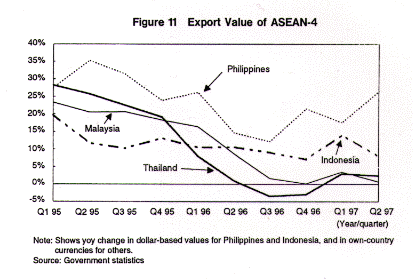
In 1996, exports suffered due to: (1) the worldwide semiconductor slump, (2) excessive appreciation of Asian currencies due to their dollar linkage, (3) price competition from Vietnam and China in textile and other labor intensive industries.
However, conditions vary by country. Korea continues to slow down as chaebols encounter problems and the won appreciates against the yen. Hong Kong and Taiwan have been undergoing an autonomous recovery process since mid 1996 centered around domestic demand. In addition, signs of recovery have appeared in exports since the spring of 1997. The currency crisis that has occurred against this backdrop has dampened economic recoveries and caused a revision of the excessive optimism surrounding Asian economies.
The present currency crisis is essentially a correction of overvalued currencies. Under the strong dollar/weak yen and weak DM since 1995, the real effective exchange rates of Asia's dollar-linked currencies rose, leading to expanding current deficits and foreign debt. In addition, the collapse of the real estate bubble in Thailand has produced a nonperforming loan problem and financial anxiety. The Thai situation can be attributed to financial liberalization policies and creation of the Bangkok offshore market in 1993, which attracted large amounts of foreign capital and caused excess liquidity. As problems emerged, funds began flowing out of Asia, currencies were sold off, and the dollar linkage policy that had caused the strong currencies failed.
Some observers view the currency crisis as signaling the limits of East Asia's growth. Since per capita income growth implies not only rising standards of living but declining export competitiveness in high-wage labor intensive industries, growth cannot continue without productivity improvement.
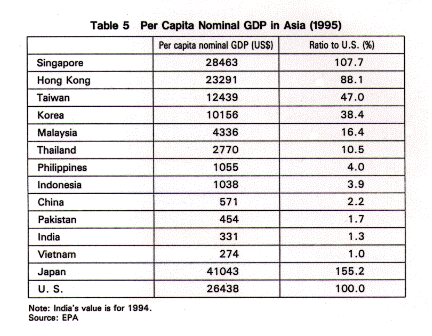
On this point, ASEAN nations still have room to catch up, and if the crisis is overcome so that inflows of foreign capital and technology resume, productivity improvements can be expected. With the high savings rate and quality labor force −factors supporting economic development thus far − basically expected to continue, medium-term growth prospects remain good.
In the meantime, however, there will be a period of adjustment for economic and financial reconstruction. While currency depreciation will improve net exports, Thailand's economy in particular is expected to decelerate due to: (1) fiscal tightening, (2) monetary tightening, and (3) balance sheet problems (nonperforming loans and foreign denominated debt). The depreciation of currencies will inevitably bring inflationary pressure.
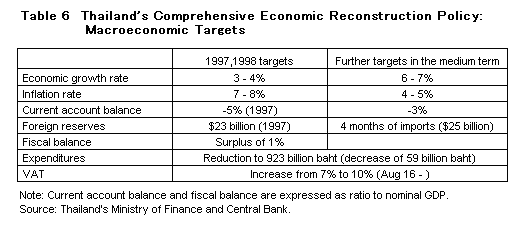
In addition, currency depreciation will decrease capital investment by raising domestic interest rates, decreasing fund flows from overseas, and producing exchange rate losses. The slowdown in private sector demand and falling exchange rates are expected to improve the high current deficit.
Due to ongoing problems −including the expansion of credit amid the rapid financial liberalization and nonperforming loans from the collapse of the bubble − the risk of further monetary and currency turmoil will linger.
the Economic Research Dept.
Research field

















